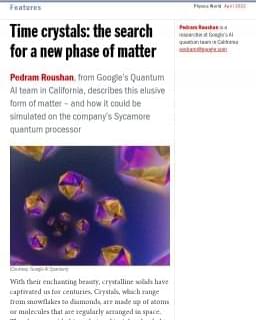Pedram Roushan, from Google’s Quantum AI team in California, describes this elusive form of matter – and how it could be simulated on the company’s Sycamore quantum processor.
With their enchanting beauty, crystalline solids have captivated us for centuries. Crystals, which range from snowflakes to diamonds, are made up of atoms or molecules that are regularly arranged in space. They have provided foundational insights that led to the development of the quantum theory of solids. Crystals have also helped develop a framework for understanding other spatially ordered phases, such as superconductors, liquid crystals and ferromagnets.
Periodic oscillations are another ubiquitous phenomenon. They appear at all scales, ranging from atomic oscillations to orbiting planets. For many years, we used them to mark the passage of time, and they even made us ponder the possibility of perpetual motion. What is common between these periodic patterns – either in space or time – is that they lead to systems with reduced symmetries. Without periodicity, any position in space, or any instance of time, is indistinguishable from any other. Periodicity breaks the translational symmetry of space or time.









Comments are closed.